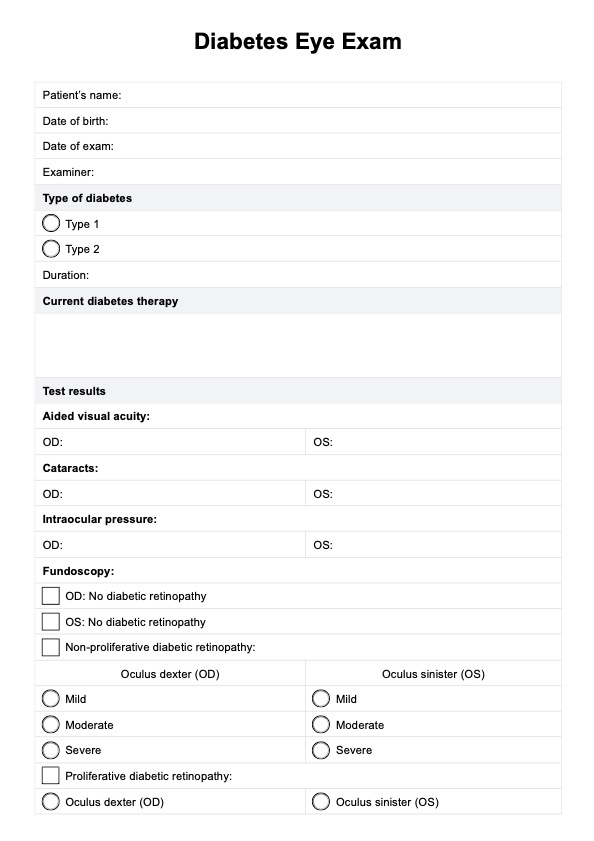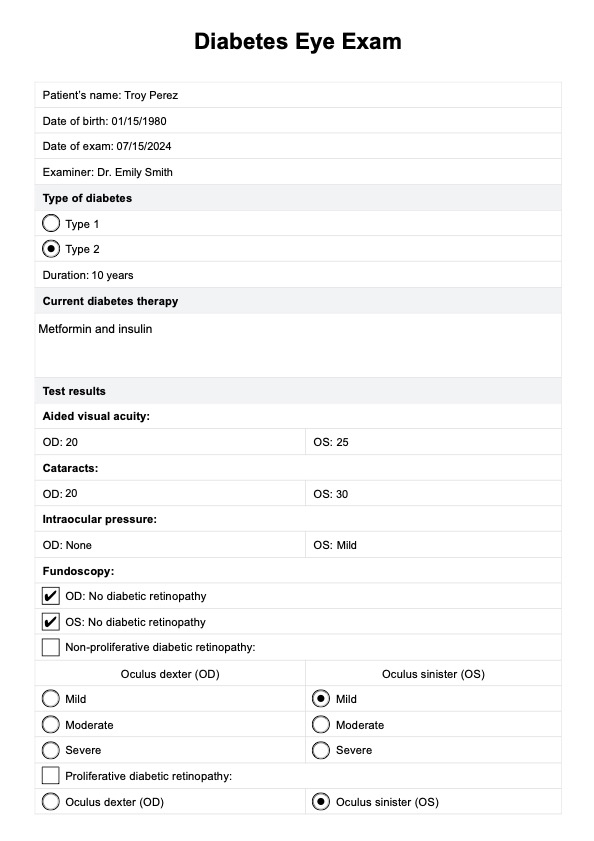Diabetes Eye Exam
Download Carepatron's free PDF template for a Diabetes Eye Exam to ensure thorough monitoring and care for diabetic patients' eye health.


Eye health and diabetes
Diabetes significantly impacts eye health, making regular eye exams essential for people with diabetes. High blood sugar levels can damage the tiny blood vessels in the eyes, leading to a range of complications. One of the most common diabetes-related eye conditions is diabetic retinopathy, where damaged blood vessels leak fluid or bleed, causing vision problems. Early treatment of diabetic retinopathy is crucial to prevent severe vision loss.
Diabetes can also increase the risk of cataracts, which cause clouding of the eye's lens, and glaucoma, a condition that damages the optic nerve due to increased pressure in the eye. Both conditions can severely affect peripheral vision and overall eye health. Therefore, it's vital for people with diabetes to have an annual eye exam to monitor these potential issues.
Eye doctors play a critical role in managing diabetes-related eye conditions. By conducting comprehensive diabetic eye exams, they can detect early signs of eye problems before significant damage occurs. Annual eye exams are recommended for everyone with diabetes, as these allow for the monitoring and management of eye health in conjunction with a primary care provider.
Diabetes Eye Exam Template
Diabetes Eye Exam Example
How to perform a Diabetes Eye Exam?
Performing a diabetes eye exam is crucial for detecting and managing eye conditions related to diabetes. The following steps outline how medical professionals should conduct a comprehensive diabetic eye exam to ensure optimal ocular health for people with diabetes.
Step 1: Access and download Carepatron's Diabetes Eye Exam template
To streamline the process, medical professionals can access and download Carepatron's Diabetes Eye Exam template. You can find this in the platform's resource library. Use it to record your test findings.
Step 2: Review patient's medical history
Before the eye exam begins, the eye doctor should review the patient's medical history. This includes understanding their diabetes management, blood sugar levels, and any existing eye conditions. Knowing the patient's history helps in identifying potential risks and tailoring the eye exam accordingly.
Step 3: Conduct a visual acuity test
The visual acuity test assesses the sharpness of the patient's vision. This step helps identify any changes in vision, such as blurred vision, which can be an early sign of diabetic retinopathy or other eye conditions.
Step 4: Examine the front of the eye
Using a slit lamp, the eye doctor examines the front of the eye, including the cornea, iris, and lens. This examination helps detect cataracts and other issues that may affect vision.
Step 5: Dilate the pupils
Dilating the pupils allows the eye doctor to get a better view of the retina and the optic nerve. This step is crucial for identifying damage to the blood vessels in the retina, new blood vessels growth, and signs of macular edema.
Step 6: Perform retinal imaging
Retinal exams, such as optical coherence tomography (OCT) or fundus photography, provides detailed images of the retina. These images help in detecting diabetic retinopathy, macular edema, and other retinal issues that might not be visible during a regular eye exam.
Step 7: Assess intraocular pressure
Measuring the intraocular pressure helps in detecting glaucoma, a condition that can damage the optic nerve. People with diabetes are at a higher risk of developing glaucoma, making this assessment a vital part of the diabetic eye exam.
Step 8: Fundoscopy
Next, a fundoscopy is performed to examine the back of the eye, including the retina, blood vessels, and optic nerve. This allows for early detection of any diabetic retinopathy or other diabetic-related changes in the eye.
Step 9: Record findings
After your Diabetes Eye Exam, record your clinical findings in the template. In this step, it is important to accurately document and record all findings from the Diabetes Eye Exam. This includes any abnormalities or concerns that were noted during the examination.
Step 10: Discuss with patient
It is also important to discuss these findings with the patient. This allows for better understanding of their eye health and any potential risks or complications that may arise due to diabetes. It also provides an opportunity for patients to ask questions or express any concerns they may have.
How can healthcare professionals benefit from our template?
Using Carepatron's Diabetes Eye Exam template provides numerous advantages for healthcare professionals. This template is designed to streamline the exam process, ensuring that all critical aspects of diabetic eye health are thoroughly evaluated. Here are five key benefits of using our template:
Improved efficiency and accuracy
Through this structured format, professionals can ensure they cover all necessary areas, including evaluating blood vessels and the retina. This reduces the likelihood of missing fine details that could indicate early stages of diabetic eye conditions.
Enhanced early diagnosis and treatment
Early diagnosis is crucial in managing diabetic eye conditions. The template guides healthcare professionals through the steps needed to detect issues such as diabetic retinopathy and macular edema in their early stages.
Comprehensive documentation
Carepatron's template ensures that all findings from the diabetic eye exam are thoroughly documented. Having detailed documentation is essential for tracking the progression of eye conditions and making informed decisions about more frequent exams or additional tests.
Streamlined patient communication
The template aids in communicating complex health issues to patients. It enhances patient understanding and encourages adherence to recommendations, such as the need for annual eye exams and the use of eye drops or contact lenses if necessary.
Facilitated coordination with other healthcare providers
The template helps in coordinating care with other healthcare providers, such as primary care physicians. It ensures that all relevant health issues related to the patient's diabetic eye health are communicated effectively.
Commonly asked questions
A diabetic eye exam includes a comprehensive evaluation of the retina, blood vessels, and optic nerve using specialized tools like retinal imaging and dilation. It focuses on detecting conditions like diabetic retinopathy, macular edema, and glaucoma.
A routine eye exam assesses overall vision and eye health, while a diabetic eye exam specifically looks for diabetes-related eye conditions. The diabetic exam involves more detailed retinal imaging and pupil dilation.
Signs include blurred vision, floaters, dark areas of vision, and difficulty seeing colors. Persistent symptoms should prompt an immediate visit to an eye doctor.
On an eye exam, diabetes can present as damaged or leaking blood vessels, swelling of the retina, or abnormal growth of new blood vessels. These signs are indicative of conditions like diabetic retinopathy or macular edema.







































































































